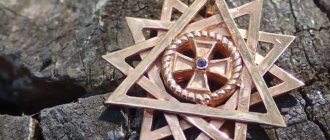Shamballa bracelet tutorial: double weaving
To begin with, let's make a list of the necessary materials:
1) Three pieces of cord. Waxed, synthetic, leather or a regular ball of wool, the main thing is that you like it. The first two cords will be the main ones, so their length should be about 40 cm. We will make knots and wrap the beads with the third, its length is 1.5 m.
2) Thread and needle.
3) Beads 24 pieces and two more for fastening. Any color, size and shape, you can choose what you like best.
4) Scissors, tape, ruler.
5) Lighter (for cauterization). Working surface.
Great, we have collected all the necessary items, now you can get started, but before that you should definitely know what weaving locks is.
In the picture, the left column indicates the weaving of the first lock, the second - the second. The lock is created by braiding the main cord (40 cm) with an additional cord (1.5 m).
How to weave a lock
1. Secure the smaller cord to the work surface (tie it to something or press down the free end)
2. Tie the larger lace to the smaller one with a regular knot. This will secure the long cord.
3. Tie the first knot according to the diagram. Direct the left end of the long cord to the right, under the right end. Then pass through the resulting loop and tighten. The first knot is ready.
4. Do the second one in exactly the same way as the first.
5. Fasten the knots to the place where you are going to place the bead.
Now you can start weaving a bracelet.
We fix the two main cords on the working surface and tie them with an additional one, making 3-4 locks. String 12 beads onto each of the main ones.
PS to make the cord pass through the beads easier, burn its end or coat it with glue. For convenience, after stringing all 24 beads, tie the remaining two ends together and weigh them down with something heavy. We move the beads to the clasps.
Take the left end of the long cord and wrap it around the first bead in a spiral.
Thus, we wrap all the beads, carefully pushing them up so that they fit more tightly.
We fix the remaining right end of the long cord on the table with tape so that it does not interfere.
Then we take the left end of the cord and perform the same operation as with the right. We lower ourselves, entangling the beads in a spiral. Remember to tighten the lace tightly.
We tie three or four locks (as in the beginning).
Next, we take the workpiece and fasten (you can use a clamp) the main laces parallel to each other.
We begin to weave locks around the secured laces. Weave as much as you need, relying on your wrist.
After completing the previous step, tie a knot on the inside of the shamballa (with a long cord). It is advisable to fix the knot with glue, but carefully.
We pull on one pair of two ends of the main cord, checking the serviceability of the bracelet. The laces should tighten smoothly.
We tie a knot from the main threads at a distance of approximately 5-7 cm and string one more bead on top of each one.
Then, we tie knots, securing additional beads, and trim off the excess ends.
Wear it with pleasure!
Video:
How to wear a bracelet correctly
In order for this talisman to have magical powers, you need to follow some rules for wearing them. Here they are:
- It is recommended to wear the bracelet only on the wrist of the right hand;
- you cannot use more than three such talismans at the same time;
- You cannot sleep in the bracelet; you must take it off at night so that it can get rid of the negative energy that accumulates during the day;
- You cannot keep several bracelets together; each of them needs to be allocated a separate storage space;
- Once every 14 days, the bracelet should be washed in tap water.
Only by following these rules for wearing an amulet will its effectiveness be guaranteed.
The Shambhala bracelet is a powerful talisman and stylish decoration for children, women and men, which has long been in fashion and is unlikely to ever cease to be relevant.
Kinds
The Shambhala bracelet in its classic modern design is a series of beads intertwined with thread. In this case, jewelry can be arranged either in one row or in several - double, triple bracelets. The number “three” is sacred in many religions, and, as a rule, the maximum number of rows in a bracelet is also three. Such a wide bracelet will add a unique flair to your style. It should be noted that the rule of “three” also applies to wearing no more than three such products on the right hand at the same time. There are also very interesting examples with woven watches, chains, and crosses.
Bracelets with names are very popular. A personal inscription made of beads, rhinestones, and a metal nameplate coated with colored enamel is added to the classic weaving of the Shambhala jewelry. Such personalized accessories will be a wonderful gift for a birthday or any other occasion.
Still, the most popular type of Shambhala bracelet is the model selected according to the zodiac sign
. This accessory will serve as a powerful amulet for its owner.
Let's consider suitable stones for the Shambhala bracelet, which are best suited for a specific zodiac sign:
- Aries
– amber, crystal, jasper, lapis lazuli, coral; - Taurus
– onyx, carnelian, malachite, tiger’s eye; - Gemini
– amethyst, charoite, citrine, moonstone; - Cancer
– pearls, aventurine, agate, peridot; - Leo
- quartz, garnet, hawk's eye, hematite; - Virgo
– turquoise, onyx, lapis lazuli, serpentine; - Libra
– tourmaline, citrine, chrysoprase, amber; - Scorpio
– agate, garnet, quartz, onyx; - Sagittarius
– amethyst, shungite, hematite, citrine; - Capricorn
– cat's eye, obsidian, moonstone; - Aquarius
– pearls, malachite, crystal, jasper; - Pisces
– agate, cacholong tiger eye.
They choose a stone for the Shambhala bracelet and, if possible, improve one or another area of a person’s life:
To achieve financial well-being, you can choose amethyst, amber, serpentine, tiger's eye. They will help attract cash flows into your life.
- To improve relationships in the family and maintain love relationships,
it is advisable to give preference to lapis lazuli, rose quartz, and moonstone as the main element for decoration. - eye and rock crystal will help against unkind people and their energy, against damage and the
evil eye. - If you have health problems
, then charoite, citrine, jasper and onyx will help improve the situation.
Selection of stones and colors
The color of the beads can be selected in accordance with the element to which the zodiac sign belongs. For example, fire signs (Aries, Leo, Sagittarius) should give preference to various red, red-orange and orange shades in beads. Signs (Taurus, Virgo, Capricorn) entering the earth element are better off choosing yellow, yellow-brown, and brown tones. For Gemini, Libra and Aquarius (element of air), green, light green and blue colors are suitable. The rest of the zodiac signs (Cancer, Scorpio, Pisces) belong to the water element, therefore the colors should be similar to the aquatic environment, i.e. blue, lilac, blue-lilac, from bright and saturated to pale and translucent.
Related article: Crochet cosmetic bag with diagram and description for beginners
All this knowledge for beginners in weaving a shamballa bracelet will be useful, because... all this will be useful in the process of work, and the direct weaving process can be examined using the example of a photo tutorial.
What is the meaning of the bracelet?
What important functions does the amulet perform?
- Protective. Protects from the influence of negative circumstances. It will attract good luck and help in overcoming life's difficulties. The stones responsible for the function are: malachite, moonstone, agate, aventurine and jade.
- Helps to find inner peace, confidence and fearlessness.
- Provides connection with your own subconscious. You will begin to better understand life, its goals and meaning, and cleanse your aura.
- Citrine, onyx, charoite, carnelian and amber resist diseases.
- Coral, rock crystal, cat's and hawk's eyes, and hematite will protect from damage.
- You can build family happiness with your other half by weaving rose quartz, carnelian, charoite, malachite and garnet into a bracelet.
Popular articles Children's knitted handbags
There are stones that will help improve health, protect, attract love and luck: jasper, agate and turquoise.
Black color is chosen by people who cannot and do not want to live according to the rules established in society.
Red will help you find your soulmate and promote love and happiness. It will also give you vital energy.
Orange will protect you from depression, charge you with positivity and attract good luck.
If you are looking for your own path in life, weave with white threads.
For those seeking natural secrets, green is the color to choose. In addition, it will give financial well-being.
If you are looking for a little romance, want to dream, use pink thread.
Gray indicates that a person is prone to loneliness.
Blue color is suitable for those seeking knowledge and wisdom. He will help you find allies for joint ventures.
If you want to find and reveal hidden talents, take the purple thread.
Brown is suitable for those who are looking for harmony and love in the family.
The main components for creating a Shambhala amulet
Weaving does not require complex and expensive materials; it is enough to purchase the following items:
- A strong rope or lace, leather, waxed or synthetic, as well as paracord threads are suitable;
- Wooden beads or stones in the desired color or colors. Materials of natural origin carry a much stronger energy charge, so you should give preference to stones and wood.
Also, don’t forget about the tools: scissors, ruler, tape, glue or lighter.
The color of the cord and beads is of great importance, because not only materials, but also colors carry different energies, which means they can serve different purposes.
How to weave a bracelet step by step
For the bracelet you will need three cords about 50 cm long, which must be tied together in a knot. For convenience, you can secure the ends of the threads with tape on a horizontal surface.
The algorithm for weaving knots is quite simple and consists of two steps that alternate with each other. In this case, the middle thread remains practically motionless. The beads will be placed on it in the future.
First step. We place the left cord on the middle one, creating a loop on the left. We shift the right cord so that it is on the free part of the left one, but under the middle one. Next, from the bottom up, carefully pull the right one into the loop formed between the middle and left cords. Now we tighten the resulting knot, in the middle of which there should be a middle fixed thread.
Second step. It is necessary to perform the same actions, but change the position of the threads: the left cord will go under the middle one, and the right one will go under the left one, but above the middle one. We pull the right cord into the loop again, but now from top to bottom. Tighten the knot. A knot formed after both steps will be considered a complete knot.
We alternate steps until approximately a quarter of the entire bracelet is ready. Now let's get back to the beads. We put the first bead on the middle cord, place it as closely as possible to the already completed knots, and then repeat step one again, braiding the bead with threads. Next, we weave several knots (depending on the size of the selected beads) and add the next one.
After the required number of beads are woven into the cords, you can return to repeating the first and second steps. In order to create neat ends, repeat step one, tighten the knot tightly, coat it with glue and, after complete drying, cut off the left and right threads. We do the same with the beginning of weaving, having previously untied the initial knot.
Schemes and tips
On the Internet you can find many weaving patterns that differ only in the algorithm for creating nodes
It is also worth paying attention to the various ways to attach a bracelet to your hand: adjustable clasps, various knots and ready-made fittings for fastening. In addition, you can make the lock yourself using the same knots, if you take a separate cord for this and instead of the middle thread use the ends of the amulet, folded together in opposite directions
Weaving a square knot
This weaving helps develop fine motor skills and attentiveness. For ease of understanding, we use multi-colored laces in our work. White is the main one, the knots are woven with a two-color cord. One side of it is blue, the other is yellow.
- There is always a vertically located main blue cord in the center. To avoid inconvenience, first secure its ends with clamps. For these purposes, you can use the lid of a shoe box.
- Under the blue main cord there is a two-color one. Its red segment should come out on the right side of the base, the yellow one on the left.
- Throw the yellow end of the lace onto the warp thread. Then we pass it under red.
- We draw a red cord under the main thread and throw it over the yellow one. We tighten it. This is our first square knot.
- We put a yellow lace on the main thread, then pass it under the red one.
- We draw a red cord under the base, throw it over the yellow one and tighten it again.
- We tie knots one by one until the thread runs out. Ready! We can begin to study the technique of creating a Shambhala bracelet.
Square knot
Having mastered basic square weaving, don’t stop there. Experiment, find training videos and photos. Improve yourself and create your own unique pattern.
Weaving for beginners:
Types of materials
When creating a bracelet, you can use beads of different qualities. These can be wooden, glass and natural stone beads, large beads. Beads are also made from polymer clay - these are very original and beautiful products that are varnished. Unique patterns and shapes give the bracelets originality.
Natural stones, if chosen correctly according to the zodiac sign or other characteristics, can become an amulet for someone who wears a Shambhala bracelet. It will bring real health benefits and protect people.
Weaving a Shambhala bracelet, or rather its result, also depends on the quality of the material, for example, the cord. It should be thick and decorative. Silk cords are often used, but nylon and waxed ones can also be used. The knots that will be knitted look very prominent and beautiful on these cords. This is what craftsmen who undertake to make a Shambhala bracelet should strive for.
Shambhala bracelets are not only a beautiful decoration. Since ancient times, it was believed that these bracelets protect a person from negativity and give inner peace, as well as strength to overcome all difficulties in life.
A master class with step-by-step photos will help you make a Shambhala bracelet with your own hands.
Materials and tools:
- Board for assembling jewelry
- White waxed cord
- Red beads – 5 pcs.
- Scissors
- PVA glue or clear nail polish
Manufacturing:
We begin to weave a bracelet from a board for assembling jewelry: it is very convenient to make accessories by stretching the main cord between two nails of the board. However, it is not at all necessary to have this tool: you can weave a shamballa bracelet without it, without fixing the warp cord anywhere. If we have a board for assembling decorations, we tie the end of a waxed cord around it. Then we measure 50 cm of the cord, starting from the nail, and cut it off.
We string the prepared beads onto the same piece of white cord, using its second (untied) end. Then this end of the cord can be tied to the second nail of the board, which is located at a distance of 30-50 cm from the first.
We unwind the second piece of cord - its length should be at least 2 m. We tie the main thread of the bracelet with this cord at the beginning of the weaving (we tie a regular but strong knot).
We position our blank for the Shamballa bracelet so that the main cord is positioned vertically, and the knot we just tied is at the top. On both sides of the knot we see two long pieces of cord, 1 m long. Take the left part of the cord: pass it under the main vertical thread and place it on top of the right cord.
Now we take the right cord, pass it over the vertical thread and bring it into the loop formed by the left thread.
We carefully tighten this combination and see that the cords are tied into a kind of knot.
This is the basic macrame knot that underlies all Shamballa bracelets.
Popular articles What do different pendants and pendants mean?
In the same way, close to the first macrame knot, weave the second one. Only this time we start with the right cord and complete the combination with the left thread.
40 macrame knots - this is exactly how much we need to knit at the beginning of the shamballa bracelet. Don’t forget to alternate the role of the cords: we start one knot on the right, the next one on the left.
We move the first red bead to the macrame knots and begin to weave it into the product. To do this, we braid the bead with a regular macrame knot.
And tighten the cords tightly.
After this, we weave three empty macrame knots and move the next bead to the weaving. We braid it with a macrame knot, then weave three knots and move the next bead. Using this pattern, we weave all five red beads into the bracelet.
After the last bead, we need to knit 35 macrame knots - 5 less than there were at the beginning of the decoration. We will weave 5 more knots later - thereby balancing the number of knots on both sides of the Shamballa bracelet.
On both sides of the bracelet, retreating 5 cm from the main thread, we tie one regular knot and cut off the cord beyond the knots. At the same time, we cover the nodes themselves with PVA glue or transparent nail polish to fix them.
Now we are making an adjustable clasp for the bracelet: here we will knit another 5 macrame knots. We connect the bracelet into a circle and put together both ends of the cord with knots. Using side cords we braid a macrame knot around them - exactly the same as all the knots on the bracelet.
Then we tighten the cords and weave 4 more knots around the two ends.
The clasp is almost ready, but we need to get rid of the side cords that will no longer be needed. We tie them into two strong knots on the wrong side of the bracelet and cut them off with scissors. Don’t forget to lubricate the knots with glue so that they don’t unravel.
We have a shamballa bracelet with an adjustable clasp. Thanks to the fact that we braided two ends of the bracelet with five macramé knots, we can now move the bracelet apart and close it so that it can be worn on any wrist.
A little history
We do not know for certain what meaning the Tibetan monks put into their creation. But we know that such a thing has been at the peak of popularity for many years, showing off in photos of celebrities. And even if you don’t put any supernatural meaning into the product, such a product will become an original and fashionable accessory.
Traditionally, the Shambhala bracelet consisted of bone beads with a carved pattern. But time passed, and gradually the tradition of creating bracelets with your own hands migrated to India. There, the classic silk laces and bone beads were replaced, and gems appeared. The classic Indian list of stones for decoration corresponds to the nine celestial bodies:
- Cat's eye is the southern lunar node of Ketu.
- Hessonite is the north south node of Rahu.
- Blue sapphire – Saturn.
- Yellow sapphire – Jupiter.
- Diamond - Venus.
- Emerald - Mercury.
- Coral - Mars.
- Pearl - Moon.
- Ruby - Sun.
However, today it is just a fashion accessory with an ancient history. Let us consider in detail how to weave a Shambhala bracelet.
Models
There are different models of bracelets in the Shambhala style. Depending on the material of the beads, these can be decorations:
- With precious stones;
- With semi-precious or ornamental stones;
- With metal beads;
- With wooden ones;
- With plastic beads;
- With beads decorated with rhinestones;
- With engraving;
- With different types of beads.
Models with beads made of natural stones are often worn not only as decoration, but also as a talisman. It is believed that a bracelet made by yourself is best suited for these purposes. Beads for the amulet are selected based on the properties that are attributed to a particular stone. As a rule, these are semi-precious stones or ornamental ones. There is a belief that a loved one should put such a bracelet on your hand for the first time, only then will the talisman work as efficiently as possible.
A separate variety is represented by personalized Shambhala bracelets, which use beads with letters that make up the name of the owner of the jewelry.
Depending on the number of rows of beads, there are:
- Bracelets with one row of beads;
- Double and triple.
Shambhala hand jewelry can have beads of different shapes. It can be:
- Round beads;
- Square;
- Curly.
Friendship bracelets are also made in the Shambhala style, the main weaving technique of which is macrame. Such jewelry is given as a sign of friendship, and it is assumed that it will be as strong as the knots of this gift. The types of weaving and colors of such souvenirs are extremely diverse; they can be both wide and narrow.
Knitting triple Shambhala
In addition to a simple double bracelet, there is a more complicated method. The set of materials will not change much, but instead of two 40 cm cords, you will need three and two 1.8 m each. And there will be 35 beads. Let’s get started.
We string the beads onto the fixed main laces. 12 on the side laces and 11 on the middle.
We take two additional cords and tie them into a small knot at the very tip (this will make it more convenient to work).
We weave three knots at the beginning, capturing all three main cords with additional ones. Make sure that the main cords do not get tangled!
We move up one bead from the outermost main laces.
We take the left additional cords and tie them around the left bead. We tie a knot.
The same on the right side, but we use the right additional lace.
We move the middle bead up and braid it with the middle ends of the additional cords.
We repeat these steps until the end.
At the end we tie three knots with additional laces (as in the beginning).
We take the workpiece and, having secured the main cords with a clamp parallel to each other, we tie additional locks on them. We do as much as is convenient for you.
We make a knot on the inside of the shamballa and secure it with glue.
We make a knot on one of the main beads (at a distance of 5-7 cm) and string the bead, then secure it with a knot on top.
We do the same with the remaining ends of the main cord.
Cut off the excess.
Videos on the same topic may also help you:











